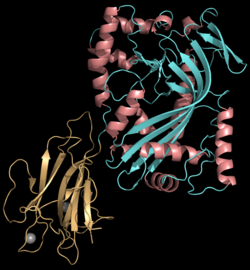| PRF1 |
|---|
 |
| Identifiers |
|---|
| Aliases |
PRF1, FLH2, HPLH2, P1, PFN1, PFP, perforin 1 |
| External IDs |
OMIM: 170280 MGI: 97551 HomoloGene: 3698 GeneCards: PRF1 |
|
| Gene location (Mouse) |
|---|
 |
| Chr. |
Chromosome 10 (mouse) |
|
| Band |
10 B4|10 32.18 cM |
Start |
61,133,612 bp |
| End |
61,140,459 bp |
|
|
|
|
| Wikidata |
|
Perforin-1 is a protein that in humans is encoded by the PRF1 gene and the Prf1 gene in mice.
Function
Perforin is a pore forming cytolytic protein found in the granules of cytotoxic T lymphocytes (CTLs) and natural killer cells (NK cells). Upon degranulation, perforin molecules translocate to the target cell with the help of calreticulin, which works as a chaperone protein to prevent perforin from degrading. Perforin then binds to the target cell's plasma membrane via membrane phospholipids while phosphatidylcholine binds calcium ions to increase perforin's affinity to the membrane. Perforin oligomerises in a Ca2+ dependent manner to form pores on the target cell. The pore formed allows for the passive diffusion of a family of pro-apoptotic proteases, known as the granzymes, into the target cell. The lytic membrane-inserting part of perforin is the MACPF domain. This region shares homology with cholesterol-dependent cytolysins from Gram-positive bacteria.
Perforin has structural and functional similarities to complement component 9 (C9). Like C9, this protein creates transmembrane tubules and is capable of lysing non-specifically a variety of target cells. This protein is one of the main cytolytic proteins of cytolytic granules, and it is known to be a key effector molecule for T-cell- and natural killer-cell-mediated cytolysis. Perforin is thought to act by creating holes in the plasma membrane which triggers an influx of calcium and initiates membrane repair mechanisms. These repair mechanisms bring perforin and granzymes into early endosomes.
Clinical significance
Homozygous inheritance of defective PRF1 alleles result in the development of familial hemophagocytic lymphohistiocytosis type 2 (FHL2), a rare and lethal autosomal recessive disorder of infancy.
Interactions
Perforin has been shown to interact with calreticulin.
See also
Further reading
-
Trapani JA (1996). "Target cell apoptosis induced by cytotoxic T cells and natural killer cells involves synergy between the pore-forming protein, perforin, and the serine protease, granzyme B". Australian and New Zealand Journal of Medicine. 25 (6): 793–9. doi:10.1111/j.1445-5994.1995.tb02883.x. PMID 8770355.
-
Peitsch MC, Amiguet P, Guy R, et al. (1990). "Localization and molecular modelling of the membrane-inserted domain of the ninth component of human complement and perforin". Mol. Immunol. 27 (7): 589–602. doi:10.1016/0161-5890(90)90001-G. PMID 2395434.
-
Young JD, Hengartner H, Podack ER, Cohn ZA (1986). "Purification and characterization of a cytolytic pore-forming protein from granules of cloned lymphocytes with natural killer activity". Cell. 44 (6): 849–59. doi:10.1016/0092-8674(86)90007-3. PMID 2420467. S2CID 30182487.
-
Young JD, Cohn ZA, Podack ER (1986). "The ninth component of complement and the pore-forming protein (perforin 1) from cytotoxic T cells: structural, immunological, and functional similarities". Science. 233 (4760): 184–90. doi:10.1126/science.2425429. PMID 2425429.
-
Lichtenheld MG, Podack ER (1990). "Structure of the human perforin gene. A simple gene organization with interesting potential regulatory sequences". J. Immunol. 143 (12): 4267–74. doi:10.4049/jimmunol.143.12.4267. PMID 2480391. S2CID 8326644.
-
Shinkai Y, Takio K, Okumura K (1988). "Homology of perforin to the ninth component of complement (C9)". Nature. 334 (6182): 525–7. Bibcode:1988Natur.334..525S. doi:10.1038/334525a0. PMID 3261391. S2CID 4348928.
-
Lichtenheld MG, Olsen KJ, Lu P, et al. (1988). "Structure and function of human perforin". Nature. 335 (6189): 448–51. Bibcode:1988Natur.335..448L. doi:10.1038/335448a0. PMID 3419519. S2CID 4359028.
-
Goebel WS, Schloemer RH, Brahmi Z (1996). "Target cell-induced perforin mRNA turnover in NK3.3 cells is mediated by multiple elements within the mRNA coding region". Mol. Immunol. 33 (4–5): 341–9. doi:10.1016/0161-5890(95)00155-7. PMID 8676885.
-
Nöske K, Bilzer T, Planz O, Stitz L (1998). "Virus-Specific CD4+ T Cells Eliminate Borna Disease Virus from the Brain via Induction of Cytotoxic CD8+ T Cells". J. Virol. 72 (5): 4387–95. doi:10.1128/JVI.72.5.4387-4395.1998. PMC 109669. PMID 9557729.
-
Andrin C, Pinkoski MJ, Burns K, et al. (1998). "Interaction between a Ca2+-binding protein calreticulin and perforin, a component of the cytotoxic T-cell granules". Biochemistry. 37 (29): 10386–94. doi:10.1021/bi980595z. PMID 9671507.
-
Yu CR, Ortaldo JR, Curiel RE, et al. (1999). "Role of a STAT binding site in the regulation of the human perforin promoter". J. Immunol. 162 (5): 2785–90. doi:10.4049/jimmunol.162.5.2785. PMID 10072525. S2CID 26096007.
-
Stepp SE, Dufourcq-Lagelouse R, Le Deist F, et al. (1999). "Perforin gene defects in familial hemophagocytic lymphohistiocytosis". Science. 286 (5446): 1957–9. doi:10.1126/science.286.5446.1957. PMID 10583959.
-
Takahashi T, Nieda M, Koezuka Y, et al. (2000). "Analysis of human V alpha 24+ CD4+ NKT cells activated by alpha-glycosylceramide-pulsed monocyte-derived dendritic cells". J. Immunol. 164 (9): 4458–64. doi:10.4049/jimmunol.164.9.4458. PMID 10779745.
-
Badovinac VP, Tvinnereim AR, Harty JT (2000). "Regulation of antigen-specific CD8+ T cell homeostasis by perforin and interferon-gamma". Science. 290 (5495): 1354–8. Bibcode:2000Sci...290.1354B. doi:10.1126/science.290.5495.1354. PMID 11082062.
-
Göransdotter Ericson K, Fadeel B, Nilsson-Ardnor S, et al. (2001). "Spectrum of Perforin Gene Mutations in Familial Hemophagocytic Lymphohistiocytosis". Am. J. Hum. Genet. 68 (3): 590–7. doi:10.1086/318796. PMC 1274472. PMID 11179007.
-
Clementi R, zur Stadt U, Savoldi G, et al. (2002). "Six novel mutations in the PRF1 gene in children with haemophagocytic lymphohistiocytosis". J. Med. Genet. 38 (9): 643–6. doi:10.1136/jmg.38.9.643. PMC 1734943. PMID 11565555.
-
Ambach A, Bonnekoh B, Gollnick H (2001). "Perforin granule release from cytotoxic lymphocytes ex vivo is inhibited by ciclosporin but not by methotrexate". Skin Pharmacol. Appl. Skin Physiol. 14 (5): 249–60. doi:10.1159/000056355. PMID 11586066. S2CID 30142804.
External links
Perforin-1 at NLM Genetics Home Reference






